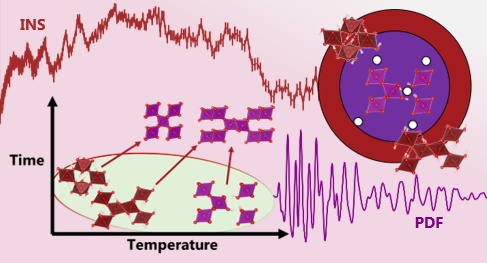
To be able to produce and store energy in a greener way, efforts are being put in the development of new materials for batteries or catalysis. The main goal being to promote chemical reactions that are not achievable on their own. This is the case for instance of the water splitting reaction, yielding oxygen and hydrogen gases that can be used in fuel cells which is usually performed using noble metals-catalysts such as platinum or iridium. However, this process is costly and the materials are scarce, thus the demand for the development of alternatives is of outmost importance. Transition metal (TM) oxide nanoparticles are promising candidates and the focus of the research developed by Nicolas Pierre Louis Magnard at Kirsten Jensen’s group at the Department of Chemistry at the University of Copenhagen in Demark.
Manganese oxides MnOx are interesting since they can give away multiple electrons, that will initiate the catalytic reaction. One form of manganese oxide that shows a high catalytic activity is γ-MnO2, that consists of the mixture of two crystal structures that are intertwined at the atomic-level. This natural defective state is made possible thanks to the insertion of hydrogen atoms in high concentration as defects, forming hydroxyl groups inside the crystal lattice. This property impacts significantly the catalytic properties of γ-MnO2. However, the mechanisms behind the formation of these defects was still unclear. Using the TOSCA neutron spectrometer at the ISIS Neutron and Muon Source, Prof. Kirsten M. Ø. Jensen and Nicolas P. L. Magnard have demonstrated that the defects form in two separate ways, that can be controlled by different synthesis parameters. Moreover, the two defect types likely locate at specific places in the nanoparticles.
They started by investigating how defect density was impacted by synthesis. Through a collaboration with scientists from the Niels Bohr Institute at the University of Copenhagen, the DanMAX beamline at the MAX IV Laboratory and the University of Helsinki, it was possible to combined X-ray Pair Distribution Function (PDF) analysis, X-ray Absorption Spectroscopy (XAS) and thermal analysis (TGA) to gain information on the local structure of a material and probe how the defects in the structure. evolve as a function of time and temperature. This combination of techniques allowed for a better understanding in how the synthesis promotes the formation each particular type of defect.
To probe the role of H-related defects, inelastic neutron scattering was the most appropriate approach. It was expected that the two types of H-related defects could be distinguished because they give rise to distinct signatures on the spectra. However, differences between the samples and reference spectra surprisingly showed that the two types of defects occupy different positions in the nanoparticles structure! While one type might be in the core of the particles, the other prefers to be located at the surface. This result is crucial since catalysed reactions occur at the surface of the catalysts.
“It was very curious to observe such different behaviour between the types of defects”, commented Magnard. “This opens the way to an improved design of catalysts, where the properties of materials could be optimised by engineering their structure and defect density via their synthesis.”
